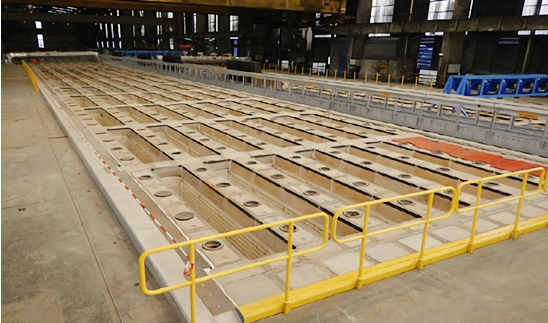- 28
- Nov
कार्बन कैल्सिनर की विभिन्न चिनाई गुणवत्ता की समस्याएं और उनके निवारक उपाय
कार्बन कैल्सिनर की विभिन्न चिनाई गुणवत्ता की समस्याएं और उनके निवारक उपाय
The problems and prevention in the process of carbon calcining furnace masonry will be shared by refractory brick manufacturers.

1. The thickness of the expansion joint of refractory brick is too large:
(1) The refractory mud has a large particle size, which affects the masonry quality, and a small particle size refractory mud of the corresponding material should be selected.
(2) आग रोक ईंटों में असंगत विनिर्देश और असमान मोटाई होती है। ईंटों का चयन सख्ती से किया जाना चाहिए। दोषपूर्ण आग रोक ईंटों जैसे लापता कोनों, मोड़ और दरारों का उपयोग नहीं किया जाना चाहिए, और ईंटों के संयुक्त आकार को आग रोक मोर्टार के साथ समायोजित किया जाना चाहिए।
(3) The refractory slurry has a large viscosity, insufficient beating, and weak ductility. When preparing the refractory slurry, the water consumption should be controlled, thoroughly stirred, and often evenly stirred during use.
(4) जब चिनाई नहीं खींची जाती है, तो यह चिनाई की ऊंचाई, समतलता और विस्तार संयुक्त आकार को डिजाइन और निर्माण आवश्यकताओं को पूरा करने में विफल कर देगा। चिनाई की गुणवत्ता सुनिश्चित करने के लिए, चिनाई कार्य में सहायता के लिए लाइन खींचना आवश्यक है।
2. अपवर्तक कीचड़ के अपर्याप्त भरने की समस्या:
(1) ईंट बनाने के दौरान आग रोक मिट्टी को बाहर नहीं निकाला जाता है, और मिट्टी की मात्रा बहुत कम होती है, इसलिए चिनाई के लिए पर्याप्त मात्रा में आग रोक मिट्टी का उपयोग किया जाना चाहिए।
(2) The laying of refractory mortar is not even enough. When beating the surface of refractory bricks, it should be as uniform as possible.
(3) ईंटों को अनुचित तरीके से लगाना। आग रोक ईंटों को रखने के बाद, अतिरिक्त दुर्दम्य कीचड़ को निचोड़ने के लिए उन्हें कई बार रगड़ना चाहिए और यह सुनिश्चित करना चाहिए कि ईंट के जोड़ों का आकार योग्य और सही है।
(4) Too wet or too dry during squeegee; prevention method: be sure to master the degree of dryness and wetness of squeegee.
(5) आग रोक ईंट का आकार अनियमित होता है, जिससे मिट्टी ईंट की सतह से समान रूप से नहीं जुड़ पाती है। आग रोक ईंट के आकार की कड़ाई से जांच की जानी चाहिए।
3. The problem of uneven size of expansion joints:
(1) The thickness of refractory bricks is uneven, and qualified refractory bricks should be screened. Those that can be treated with slurry can be leveled with refractory slurry.
(2) धड़कन की प्रक्रिया अधिक और कभी-कभी कम होती है, और हर बार की मात्रा अलग होती है, और यह सुनिश्चित करने के लिए कि कीचड़ की मात्रा सुसंगत है, संचालन की संख्या की जानी चाहिए।
(3) For bricklaying without cables, cables must be used for masonry to ensure that the horizontal elevation of each layer of masonry meets the design and construction requirements.
(4) The size of the expansion joint is large and small, and the joint thickness of each refractory brick should be strictly controlled.
(5) The refractory slurry is not uniformly stirred. During the preparation process, strictly control the gray-water ratio, adjust the viscosity, and often stir during use.
4. ऊपरी और निचले विस्तार जोड़ों की असमान मोटाई की समस्या:
(1) केबल से सहायता प्राप्त चिनाई कार्य करने में विफलता के परिणामस्वरूप, केबल-ड्राइंग ऑपरेशन को कड़ाई से नियंत्रित और स्पष्ट रूप से चिह्नित किया जाना चाहिए।
(2) The horizontal joints of the masonry are not leveled, and the horizontal elevation of each layer of masonry and the leveling treatment are strictly controlled.
5. आयताकार भट्ठी की दीवार की असमान ऊंचाई की समस्या:
(1) The corner masonry is not standardized, and experienced users should be used to build the corner.
(2) जब चिनाई को बढ़ाया नहीं जाता है, तो आग रोक ईंटों की प्रत्येक परत के स्तर को सुनिश्चित करने के लिए चिनाई को बढ़ाया जाना चाहिए।
(3) When there are two or more people before and after the masonry, the construction methods are different, and the thickness and size of the refractory mortar are not the same. The masonry operation method of each construction worker should be standardized to ensure the uniformity of the masonry quality and the size of the brick joints. .
(4) The refractory slurry is not uniformly stirred. During the preparation process, strictly control the gray-water ratio, adjust the viscosity, and often stir during use.
(5) Wet refractory bricks or after being exposed to rain will no longer absorb the moisture in refractory mud. Do not use damp refractory bricks for masonry. After being drenched in rain, the refractory bricks must be dried before use.
6. The problem of uneven or parallel height of symmetrical arch feet:
(1) जब चिनाई को बढ़ाया नहीं जाता है, तो आग रोक ईंटों की प्रत्येक परत के स्तर को सुनिश्चित करने के लिए चिनाई को बढ़ाया जाना चाहिए।
(2) विस्तार जोड़ों का आकार एक समान नहीं होता है, इसलिए प्रत्येक आग रोक ईंट की संयुक्त मोटाई को कड़ाई से नियंत्रित किया जाना चाहिए।
(3) दो सममित भट्ठी की दीवारें एक साथ नहीं बनाई गई हैं, क्योंकि वे क्रमिक चिनाई के कारण अलग-अलग ऊंचाइयों का कारण बनती हैं। यदि आगे और पीछे की चिनाई का निर्माण किया जाता है, तो आग रोक ईंटों की प्रत्येक परत के जोड़ों के आकार को कड़ाई से नियंत्रित किया जाना चाहिए।
(4) जब दो दीवारें बनाई जाती हैं, तो इस्तेमाल की जाने वाली आग रोक ईंटों की सूखापन और नमी की डिग्री अलग होती है। नम आग रोक ईंटों का उपयोग चिनाई के लिए नहीं किया जाना चाहिए, और सुखाने के बाद उपयोग किया जाना चाहिए।
(5) When there are two or more people building two walls, the construction methods are different, and the thickness of the refractory mortar is not the same. The masonry operation method of each constructor should be standardized to ensure the quality of the masonry and the size of the brick joints. Unite.
